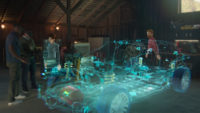Microsoft Mesh Aims to Bring VR/AR Devices, Users Together
March 4, 2021
Microsoft Mesh is a new mixed-reality platform powered by Azure that enables people in different locations to meet and collaborate as digital representations of themselves in holographic experiences across a variety of devices. To demonstrate the shared experience, Microsoft technical fellow Alex Kipman appeared at the company’s Ignite digital conference this week via holoportation, and was joined by Cirque du Soleil co-founder Guy Laliberté, filmmaker James Cameron and Niantic CEO John Hanke to discuss related initiatives. Microsoft announced two apps built on the platform — a preview version for HoloLens 2 and a new Mesh-enabled version of AltspaceVR.
The Microsoft Mesh preview app for HoloLens (below) is currently available for download. It allows users to “join remote collaboration sessions … customize expressive avatars … import 3D content from OneDrive … save spaces for synchronous and asynchronous collaboration … [and] ink and annotate content.”

The new AltspaceVR version “will allow companies to hold meetings and work gatherings in virtual reality with enterprise-grade security features including secure sign-ins, session management and privacy compliance,” according to a post on the Microsoft news site. “Over time, the company said it expects customers will be able to choose from a growing set of Microsoft Mesh-enabled applications built by external developers and partners, and also to benefit from planned integration with Microsoft products such as Microsoft Teams and Dynamics 365.”
Microsoft Mesh is designed to “enable geographically distributed teams to have more collaborative meetings, conduct virtual design sessions, assist others, learn together and host virtual social meetups,” explains the post. “People will initially be able to express themselves as avatars in these shared virtual experiences and over time use holoportation to project themselves as their most lifelike, photorealistic selves.”
“With Microsoft Mesh-enabled applications, designers or engineers who work with 3D physical models — anything from bicycles to high-end furniture to jet engines to new sports stadiums — could appear as themselves in a shared virtual space to collaborate and iterate on holographic models, regardless of their physical location.”

The new platform aims to enable such experiences on devices of all price points from different manufacturers. That includes Microsoft’s own $3,500 HoloLens augmented reality goggles, Facebook’s Oculus, other VR headsets, as well as mobile phones and computers that offer a 2D view.
Bloomberg reports that Microsoft’s Kipman “described the product and answered questions through his holographic avatar … using both a HoloLens and an HP Reverb headset in turn.” Although Facebook, HP and Snap have released various “goggles and glasses,” neither AR or VR have attained mass usage, and “Microsoft is betting that a set of cloud-based tools to make it easier to develop compelling AR and VR applications for almost any type of device will have broader appeal.”
Microsoft chief executive Satya Nadella noted that, “as more AR and VR experiences become available for larger groups, phones and PCs allow a way in without expensive devices.”
Hanai World, Guy Laliberté’s new company, “plans to use Mesh to create entertainment events that mix live and virtual aspects” to preview by end of 2021. Niantic is working on “games and services … and hopes to use Mesh for things like programming the presence of two or more holograms.” OceanX, a marine science nonprofit, and Accenture also have plans to use Mesh.
Kipman noted that complex scenarios still require more work, which is “why sports programming is still a way off … [since] it would require sensor tracking on too many players and too large a space.”
“Microsoft Mesh is a kind of framework for new level of ‘holoportation,’ so that app makers can design experiences where people really are interacting with each other in virtual or semi-virtual worlds,” reports Wired. Mesh in VR will be comparable to Oculus Spaces and other lesser-known apps. In AR, Microsoft Mesh produced Kipman’s avatar as “a hologram in [the] living room” and is aimed at lightweight glasses rather than the 1.5-pound HoloLens 2.
Kipman said he and the company are “thrilled by the competition,” although Hanke said he thinks “it will still be a couple years before we see a consumer-friendly glasses experience.”
Related:
Help! Microsoft Put a Holographic James Cameron in My Basement, The Wall Street Journal, 3/2/21

No Comments Yet
You can be the first to comment!
Sorry, comments for this entry are closed at this time.